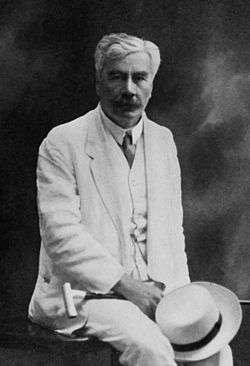Marc Armand Ruffer
Sir Marc Armand Ruffer CMG (29 August 1859[1] – 15 April 1917) was a Swiss-born British experimental pathologist and bacteriologist. He is considered a pioneer of modern paleopathology.[2]

Family
Ruffer was born in Lyon, the son of Swiss banker Baron Alphonse Jacques Ruffer and his German wife, Caroline, who were resident in Switzerland at time of his own death.[3] Ruffer married Alice Mary Greenfield in 1890 and had three children, including Nina Ruffer, who studied anthropology at Somerville College, Oxford and was mentioned by Vera Brittain in the Testament of Youth.
Education
He was educated in Germany and France before attending Brasenose College, Oxford (1878–1881) and reading medicine University College London. He also studied at the Pasteur Institute in Paris under Louis Pasteur.[1]
Career
Ruffer was naturalized as a British citizen in 1890. In 1891, he was appointed the first director of the British Institute of Preventive Medicine, latterly the Lister Institute.
Moving to Egypt for health reasons, Ruffer was appointed a professor of bacteriology at The Faculty of Medicine, Cairo University in 1896, later taking roles on committees dealing with health, disease, and sanitation. In Egypt he worked on the histology of mummies publishing his findings and helping to establish the field of paleopathology.
Ruffer was made a Companion of the Order of St Michael and St George (CMG) in 1905[4] and knighted in 1916. He also received the Grand Cross of the Ottoman Orders of Osmanieh and the Medjidie, the Order of the Redeemer (2nd class) of Greece, and was Commander (2nd class) in the Order of St Anne of Russia and the Crown of Italy.[4]
He went to Greece during the First World War in capacity as Commissioner of the British Red Cross Society to improve sanitation. Returning to Egypt on board the ship SS Arcadian[5] on 15 April 1917, his ship was torpedoed off the Greek coast near the island of Milos without warning by the German submarine UC-74 with the loss of 279 lives, 35 of which were crew.
He was seen twice in the sea, first alive and upright and then floating, believed dead. His body was never recovered from the sea. He was declared legally dead in 1918.[6][7]
After research by the In from the Cold Project, he was accepted on 17 September 2016 for commemoration by the Commonwealth War Graves Commission on their Mikra Memorial in Kalamaria, Thessaloniki, Greece, to those who have no known grave.[3][8]
Lady Ruffer died in Alexandria in 1950.[9]
References
- Cardin, Matt (2014). Mummies around the World: An Encyclopedia of Mummies in History, Religion, and Popular Culture: An Encyclopedia of Mummies in History, Religion, and Popular Culture. ABC-CLIO. p. 376. ISBN 9781610694209. Retrieved 29 April 2019.
- Sandison, Andrew T. 'Sir Marc Armand Ruffer (1859–1917):Pioneer of Paleopathology.' The Global History of Paleopathology: Pioneers and Prospects, ed. Jane Buikstra, and Charlotte Roberts (New York, 2012) 106
- CWGC Casualty record, Sir Marc Armand Ruffer.
- Kelly's Handbook to the Titled, Landed and Official Classes, 1916. Kelly's. p. 1283.
- "S.S.Arcadian at the Roll of Honour website". Retrieved 28 July 2012.
- "Probate, Divorce, and Admiralty Division – Motion to Presume the Death of Sir M. Ruffer". The Times. The Times Digital Archive. 31 July 1917. p. 2.
- "Probate, Divorce, and Admiralty Division – Presumption of Sir M. A. Ruffer's Death". The Times. The Times Digital Archive. 14 May 1918. p. 4.
- "Archived copy". Archived from the original on 2015-05-19. Retrieved 2015-05-11.CS1 maint: archived copy as title (link) In From The Cold Project casualty record.
- "Obituaries: Lady Ruffer". The Times. The Times Digital Archive. 12 January 1950. p. 8.
- Carol R. Ember & Melvin Ember (2003). Encyclopedia of Medical Anthropology: Health and Illness in the World's Cultures Topics. Springer. pp. 50. ISBN 978-0-306-47754-6.
- A. T. Sandison (1 April 1967). "Sir Marc Armand Ruffer (1859–1917) pioneer of palaeopathology". Medical History. 11 (2): 150–6. doi:10.1017/s002572730001200x. PMC 1033695. PMID 5342754.